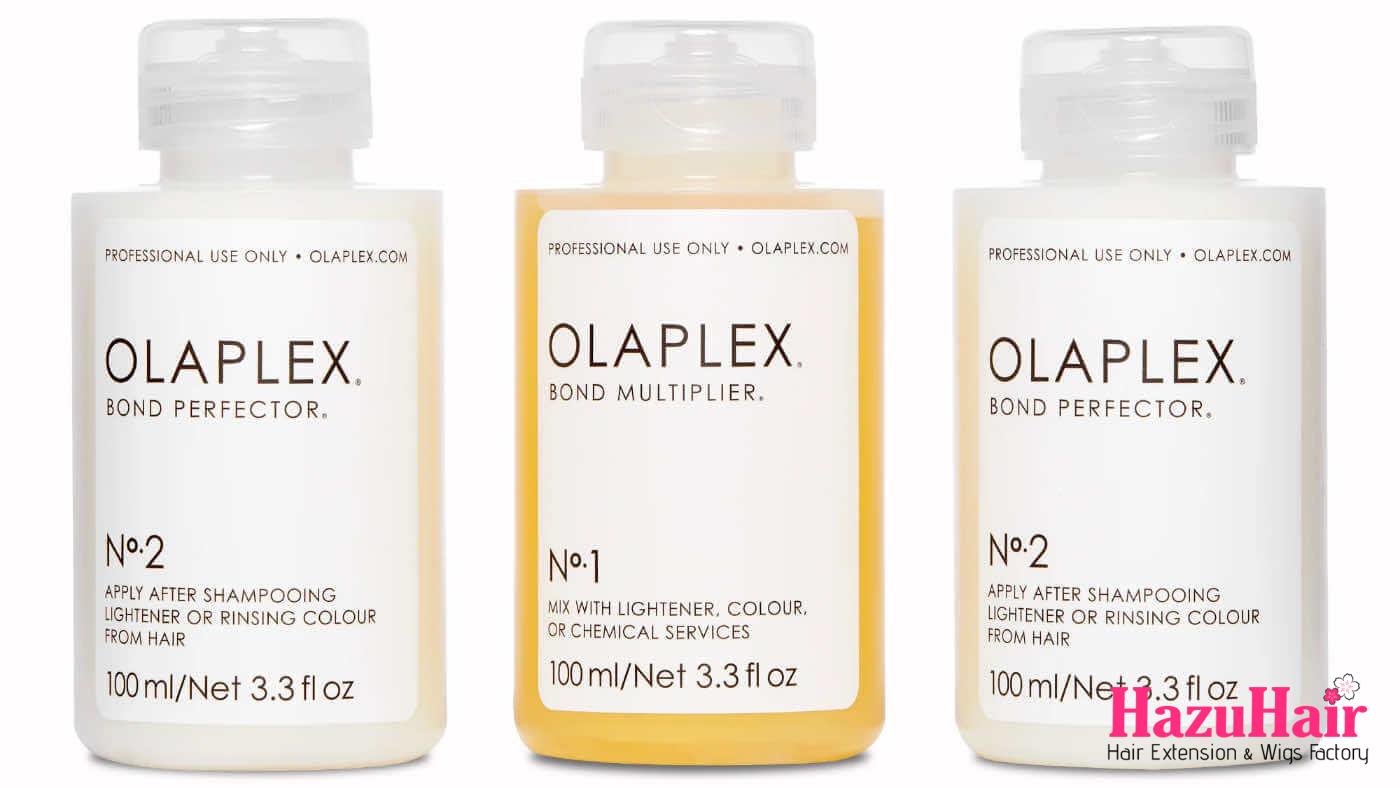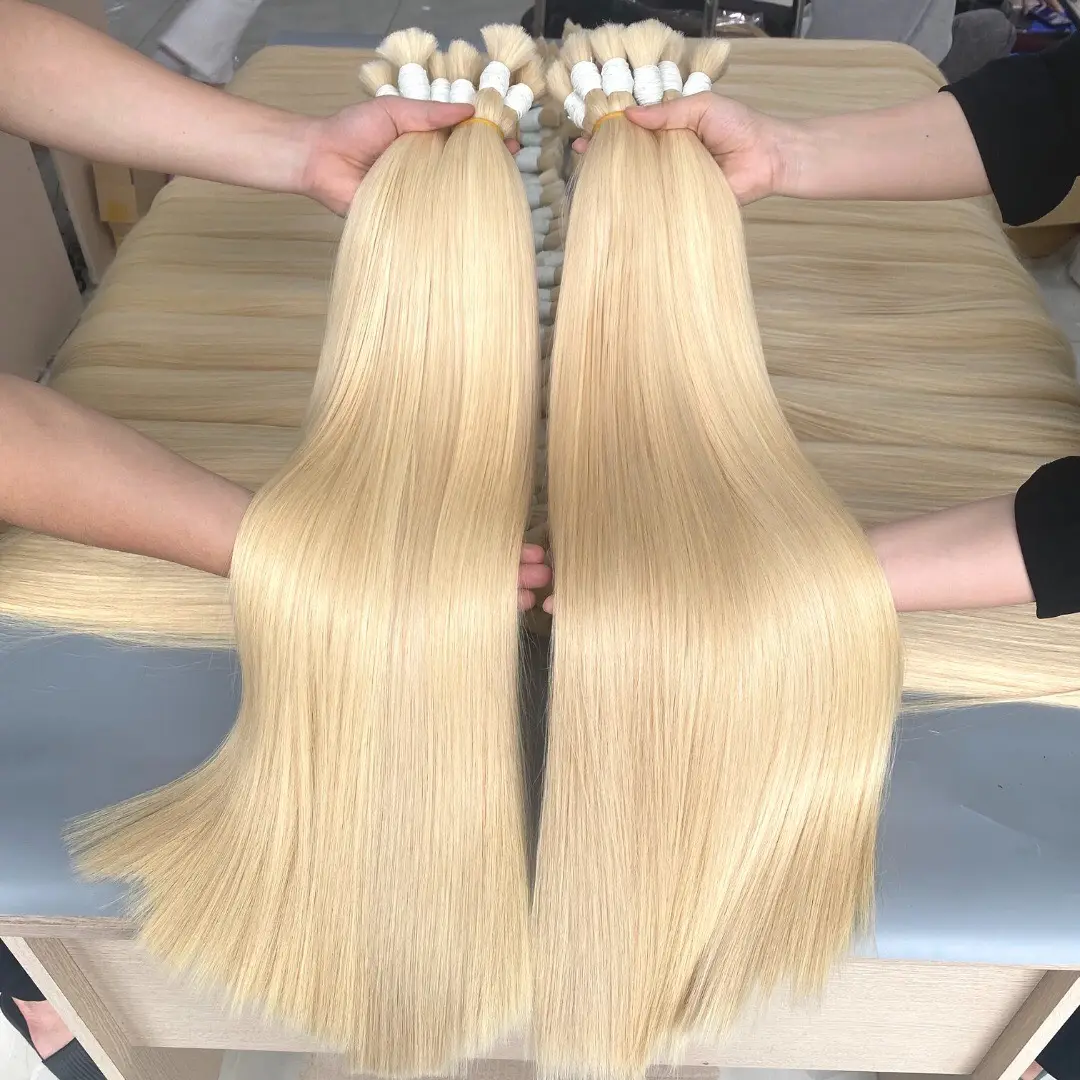Hair knowledge
Why Virgin Hair Cannot Be Bleached to 613 Color
Why Can Raw Hair Be Bleached to #613, While Virgin Hair Only Reaches #27?
The answer lies in the health and quality of the hair’s cuticle and cortex. Hair with intact, healthy cuticles and strong cortex layers can be bleached to the lightest blonde shade, #613. On the other hand, hair with less integrity is limited to #27.
1. Understanding Hair Structure
1.1 Hair Strand Structure
To understand why this difference occurs, it’s important to grasp the basic structure of hair, which consists of three layers:
- Cuticle: The outermost layer that protects the hair.
- Cortex: The middle layer where the pigments reside.
- Medulla: The innermost layer, often absent in fine hair.

1.2 Composition and Functions
Hair is primarily composed of insoluble keratin, a type of protein. The structure from the outside in includes the cuticle, cortex, and medulla.
- Cuticle: This outer layer comprises 6-12 overlapping scales, resembling fish scales, which serve as a protective shield for the hair. The cuticle’s condition determines whether hair feels smooth or rough. When the scales are neatly aligned, the hair appears shiny and smooth. If the scales are raised, the hair feels coarse and rough.
You can feel the cuticle’s presence by running your fingers along a strand of hair. Moving your hand downwards with the direction of hair growth feels smooth, while moving upwards against the grain feels much rougher, due to the raised cuticle scales.
- Cortex: Making up about 77-80% of the hair’s volume, the cortex consists of fibrous proteins and is responsible for many of the hair’s characteristics, including color and texture. The cortex is composed of spiral protein fibers (macro and microfibrils) that give hair its strength and elasticity.
- Medulla: The medulla is the innermost part of the hair, forming a loose core that accounts for about 5% of the hair’s structure. Not all hair strands contain a medulla, especially fine hair.
1.3 Hair Color and the Cortex
The cortex plays a central role in determining hair color, as it contains the pigments that give hair its hue. These pigments come in shades of black, brown, red, yellow, and blue. The combination of pigments varies by ethnicity, with Asians generally having black, red, yellow, and blue pigments, resulting in black hair, while Europeans tend to have brown, red, and yellow pigments, giving them brown or blonde hair.
Chemical dyeing and bleaching processes mainly affect the cortex, as they work by altering or removing the pigments within this layer.
2. Hair Bleaching and Dyeing Process
2.1 The Principles of Hair Bleaching and Dyeing
Understanding the structure of hair helps clarify how the dyeing process works. There are two main methods: physical dyeing and chemical dyeing.
- Physical Dyeing involves applying color directly to the hair’s cuticle layer. This method offers temporary results, often washing out after just one shampoo. Products like temporary hair sprays or dyes work this way and are perfect for short-term events such as cosplay, music festivals, or family visits. Since physical dyeing doesn’t penetrate the hair’s structure, it causes minimal damage and can be removed easily with regular shampoo.
- Chemical Dyeing, however, alters the internal structure of the hair by penetrating the cortex and changing its pigments. Before dyeing chemically, the hair must be bleached to remove existing pigments and allow new color to take hold.

2.2 The Hair Bleaching Process
Because hair color is determined by pigments in the cortex, and the cuticle protects the cortex, bleaching first requires opening the cuticle. The cuticle opens in alkaline conditions, which is why bleach contains developer with hydrogen peroxide—an alkaline agent with a strong odor.
Once the cuticle is open, bleaching powder enters the cortex and dissolves the hair’s melanin. Typically, a 20-volume developer (though some use 30-volume) mixed with bleach is applied for 30 minutes to lift the hair to level #27. If you want to reach #613, the process takes about 60 minutes or might require an additional bleaching round.
Since bleaching can damage hair, we recommend using high-quality products combined with repair treatments such as Olaplex No.1 or No.2. These treatments help restore damaged disulfide bonds in the hair, reducing the impact of the bleaching process.
>> See more: How to Bleach Your Natural Hair to 613 Blonde


2.3 Hair Bleaching Levels
Asian hair typically follows this bleaching progression:
- Black → Dark Brown → Reddish Brown → Light Brown → Dark Gold → Gold (#27) → Light Gold → Very Light Gold (#613) → Pale Gold (#60) → Platinum Gold.

2.4 Using Toner Shampoo
When aiming for pastel or light colors like pink, green, or grey, bleaching to level 9 or higher is required. However, achieving level 9 can be tricky due to the remaining yellow pigments. These pigments can interfere with coloring, making the desired shade difficult to attain.
Toner shampoo helps resolve this issue. It contains purple pigments that neutralize the yellow tones, resulting in a cleaner, lighter blonde. Toner shampoo is particularly effective for hair bleached to level 9 or above but has little to no effect on lower levels.
2.5 We Recommend Buying #613 Hair for Coloring
For customers who already know their desired hair color, we recommend purchasing #613 hair extensions for easier coloring.
We offer four types of #613 hair to meet different needs. If you’re looking for short-term color lasting one to two weeks, we suggest our BVRG613 series, starting at just $22.22.
For clients with higher coloring standards, we recommend VR613 or TR613, which undergo a slow bleaching process to preserve hair cuticle integrity. These premium products allow for quick and flawless coloring.
Opting for #1B hair and bleaching it yourself adds time, cost, and risks. Improper bleaching can damage the hair’s cuticles and cortex, potentially leading to poor coloring results.
3. Why Can Raw Hair Be Bleached to 613?
Our Top Raw Hair and Vietnamese Raw Hair contain more brown pigments compared to the darker, black-pigmented Burmese hair. This allows them to be bleached to #613 (approximately level 9-10). In some cases, toner shampoo may be required to lift the hair color to the desired level.
Additionally, the cuticles of Top Raw Hair and Vietnamese Raw Hair are healthy and intact, while the cortex remains strong and undamaged. As a result, even after bleaching to 613, the hair retains its strength and health.
On the other hand, Burmese Raw Hair, with its higher concentration of black pigment, can typically only be bleached to a lighter shade of #27 (around level 7-8). Despite having healthy cuticles and a robust cortex, it cannot be lightened beyond this point.

4. Why Can’t Virgin Hair Be Bleached to 613?
Virgin hair cannot be bleached to #613, only to #27, for several reasons:
Firstly, the cuticles of virgin hair are often straightened by machines, making them less intact compared to raw hair. As a result, virgin hair’s cortex is not as strong as that of raw hair. Additionally, Burmese Virgin Hair and Indian Virgin Hair contain more black pigment. While they can be bleached to level 27 with usable results, continuing to bleach beyond this point would damage the hair’s cortex, leaving it dry, brittle, and prone to breakage.
In summary, virgin hair cannot withstand the process needed to reach #613, and attempting to bleach further would result in severe damage.
5. Post-Bleaching Hair Care
Conditioner plays a crucial role in maintaining the smoothness and shine of bleached hair. Shampoos typically contain alkaline ingredients that open the hair cuticles, which can leave hair feeling rough and frizzy if dried immediately afterward. Conditioners help temporarily close the cuticles, making the hair smoother and less prone to tangling.
However, many people use conditioner incorrectly by applying it directly after washing and rinsing it out too quickly. This does not allow the hair to become properly smooth. Instead, after washing, you should towel-dry your hair first until no visible water droplets remain. Then, apply an even amount of conditioner or a hair mask to your hair.
There is no need to fully rinse out the conditioner. The silicone content helps the conditioner adhere to the hair, making it smooth. You can stop rinsing once the water is no longer cloudy or slippery to the touch.
As for choosing a conditioner, most brands do not differ significantly. If you have a favorite brand that works well for you, feel free to continue using it.
In theory, all 1B hair can be lightened to #613, but the process can be damaging. Only strong, raw hair is suitable for bleaching to #613. For the best results, virgin hair should not be bleached beyond #27, as doing so can lead to dryness and breakage.
We hope this explanation helps you educate your clients about the effects of bleaching different hair types. With our expertise, we’re here to assist you in choosing the best products for your business and customers.

Where to Buy Quality Hair That Can Be Bleached to Blonde 613
Looking for the best place to buy quality hair that can be bleached to Blonde 613? If your natural hair is too weak for bleaching, hair extensions are a great solution. However, beware of low-quality hair from unreliable sources. Choosing a reputable hair company is key to ensuring you get the best results.

HazuHair Vietnam is a trusted supplier of premium Vietnamese hair, recognized by customers worldwide, particularly in the US, EU, Russia, and Nigeria. We offer a diverse selection of high-quality hair extensions that can meet your color, texture, and style requirements, including our stunning Blonde 613.
If you have any questions, feel free to contact us! We’re here to help. Ready to experience true high-quality hair? Order our Raw Vietnamese hair or 613 color hair today!
Contact HazuHair – Raw Vietnamese Hair Supplier
- Hair Factory: Tan Son 2 Village, Tan Dinh, Lang Giang, Bac Giang Province, Vietnam
- Hotline: +849 4949 3883
- Whatsapp Mrs ThanhLam: https://wa.me/84949493883
- Website: https://hazuhair.com
